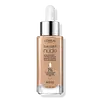Dr Sam’s Flawless Gossamer Tint SPF50 (Tint 01-Fair or Pale) Versus L'Oreal True Match Nude Hyaluronic Tinted Serum
What's inside
What's inside
 Key Ingredients
Key Ingredients

 Benefits
Benefits

 Concerns
Concerns

 Ingredients Side-by-side
Ingredients Side-by-side

Water
Skin ConditioningCaprylic/Capric Triglyceride
MaskingZinc Oxide
Cosmetic ColorantOctyldodecyl Neopentanoate
EmollientTitanium Dioxide
Cosmetic ColorantButyrospermum Parkii Butter
Skin ConditioningHydroxyethyl Acrylate/Sodium Acryloyldimethyl Taurate Copolymer
Emulsion StabilisingPolyhydroxystearic Acid
EmulsifyingSqualane
EmollientCetearyl Alcohol
EmollientPhenoxyethanol
PreservativeSodium Stearoyl Glutamate
CleansingSodium Hyaluronate
HumectantPolysorbate 60
EmulsifyingAlumina
AbrasiveAluminum Stearate
Cosmetic ColorantHydrogenated Polydecene
EmollientCarbomer
Emulsion StabilisingSodium Hydroxymethylglycinate
Preservative1,2-Hexanediol
Skin ConditioningDisodium EDTA
Isostearic Acid
CleansingEthylhexylglycerin
Skin ConditioningSorbitan Isostearate
EmulsifyingBiosaccharide Gum-4
Skin ConditioningDisteardimonium Hectorite
StabilisingPropylene Carbonate
SolventCitric Acid
BufferingCI 77492
Cosmetic ColorantCI 77891
Cosmetic ColorantCI 77491
Cosmetic ColorantCI 77499
Cosmetic ColorantWater, Caprylic/Capric Triglyceride, Zinc Oxide, Octyldodecyl Neopentanoate, Titanium Dioxide, Butyrospermum Parkii Butter, Hydroxyethyl Acrylate/Sodium Acryloyldimethyl Taurate Copolymer, Polyhydroxystearic Acid, Squalane, Cetearyl Alcohol, Phenoxyethanol, Sodium Stearoyl Glutamate, Sodium Hyaluronate, Polysorbate 60, Alumina, Aluminum Stearate, Hydrogenated Polydecene, Carbomer, Sodium Hydroxymethylglycinate, 1,2-Hexanediol, Disodium EDTA, Isostearic Acid, Ethylhexylglycerin, Sorbitan Isostearate, Biosaccharide Gum-4, Disteardimonium Hectorite, Propylene Carbonate, Citric Acid, CI 77492, CI 77891, CI 77491, CI 77499
Water
Skin ConditioningIsododecane
EmollientDimethicone
EmollientAlcohol Denat.
AntimicrobialTrimethylsiloxysilicate
EmollientButylene Glycol
HumectantPEG-10 Dimethicone
Skin ConditioningPerlite
AbsorbentSodium Hyaluronate
HumectantNylon-12
Isopropyl Lauroyl Sarcosinate
Skin ConditioningDiisopropyl Sebacate
EmollientDisteardimonium Hectorite
StabilisingHdi/Trimethylol Hexyllactone Crosspolymer
Bis-PEG/PPG-14/14 Dimethicone
EmollientMagnesium Sulfate
Synthetic Fluorphlogopite
Ethylhexyl Hydroxystearate
EmollientPhenoxyethanol
PreservativeCellulose
AbsorbentDipentaerythrityl Tetrahydroxystearate/Tetraisostearate
Skin ConditioningSilica
AbrasiveSilica Silylate
EmollientDisodium Stearoyl Glutamate
CleansingCalcium Carbonate
AbrasiveCalcium Aluminum Borosilicate
Tocopherol
AntioxidantMoroccan Lava Clay
AbrasiveGlycerin
HumectantEmpetrum Nigrum Fruit Juice
Skin ConditioningAluminum Hydroxide
EmollientPotassium Sorbate
PreservativeCI 77491
Cosmetic ColorantCI 77492
Cosmetic ColorantCI 77499
Cosmetic ColorantCeramide AP
Skin ConditioningWater, Isododecane, Dimethicone, Alcohol Denat., Trimethylsiloxysilicate, Butylene Glycol, PEG-10 Dimethicone, Perlite, Sodium Hyaluronate, Nylon-12, Isopropyl Lauroyl Sarcosinate, Diisopropyl Sebacate, Disteardimonium Hectorite, Hdi/Trimethylol Hexyllactone Crosspolymer, Bis-PEG/PPG-14/14 Dimethicone, Magnesium Sulfate, Synthetic Fluorphlogopite, Ethylhexyl Hydroxystearate, Phenoxyethanol, Cellulose, Dipentaerythrityl Tetrahydroxystearate/Tetraisostearate, Silica, Silica Silylate, Disodium Stearoyl Glutamate, Calcium Carbonate, Calcium Aluminum Borosilicate, Tocopherol, Moroccan Lava Clay, Glycerin, Empetrum Nigrum Fruit Juice, Aluminum Hydroxide, Potassium Sorbate, CI 77491, CI 77492, CI 77499, Ceramide AP
 Reviews
Reviews

Ingredients Explained
These ingredients are found in both products.
Ingredients higher up in an ingredient list are typically present in a larger amount.
Ci 77491 is also hydrated iron III oxide. It's sole purpose is to give a red/pink hue to products.
Iron III oxides are classified as inorganic chemicals for coloring.
Synthetically created Ci 77491 is considered safer than those naturally found. This is because the synthetically created version may contain less impurities. Iron oxides are generally non-toxic and non-allergenic.
Learn more about CI 77491Ci 77492 is also hydrated iron III oxide. It's sole purpose is to give a yellow hue to products.
Iron III oxides are classified as inorganic chemicals for coloring.
Synthetically created Ci 77492 is considered safer than those naturally found. This is because the synthetically created version may contain less impurities. Iron oxides are generally non-toxic and non-allergenic.
Learn more about CI 77492Ci 77499 is also hydrated iron III oxide. It is created from mixing red and black iron oxides. This helps give shades of darkness to a product.
Iron III oxides are classified as inorganic chemicals for coloring.
Disteardimonium Hectorite comes from the clay mineral named hectorite. It is used to add thickness to a product.
It can also help stabilize a product by helping to disperse other ingredients.
Hectorite is a rare, white clay mineral.
Learn more about Disteardimonium HectoritePhenoxyethanol is a preservative that has germicide, antimicrobial, and aromatic properties. Studies show that phenoxyethanol can prevent microbial growth. By itself, it has a scent that is similar to that of a rose.
It's often used in formulations along with Caprylyl Glycol to preserve the shelf life of products.
Sodium Hyaluronate is hyaluronic acid's salt form. It is commonly derived from the sodium salt of hyaluronic acid.
Like hyaluronic acid, it is great at holding water and acts as a humectant. This makes it a great skin hydrating ingredient.
Sodium Hyaluronate is naturally occurring in our bodies and is mostly found in eye fluid and joints.
These are some other common types of Hyaluronic Acid:
Learn more about Sodium HyaluronateWater. It's the most common cosmetic ingredient of all. You'll usually see it at the top of ingredient lists, meaning that it makes up the largest part of the product.
So why is it so popular? Water most often acts as a solvent - this means that it helps dissolve other ingredients into the formulation.
You'll also recognize water as that liquid we all need to stay alive. If you see this, drink a glass of water. Stay hydrated!
Learn more about Water